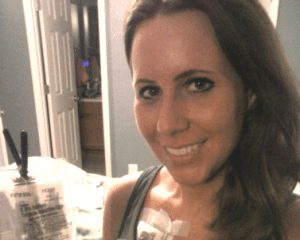Eighty-five-year-old Frank Meuers considers his 500th immunoglobulin infusion to be a cause for celebration. Frank has logged details of his doctor’s visits since his first dose of replacement therapy with intravenous immunoglobulin (IVIG) when he was 20 years old. Frank recommends maintaining diaries as a patient can easily respond to the many questions posed by the physicians.
Frank’s Journey
Frank was in his 20s when he began his search for a diagnosis. He had served in the United States Navy for four years then completed his degree in education. Frank was plagued with skin issues and chronic respiratory infections. In 1962, he went to a doctor. The doctor acknowledged that Frank had many symptoms then admitted that he did not know what caused them.
Frank’s continuous respiratory infections had a strong impact on his career as a middle school teacher.
He later developed gastrointestinal (GI) issues. The doctor discovered that he had low immunoglobulin.
Further tests identified nodules in Frank’s intestines, Gilbert’s syndrome, and inflamed blood vessels affecting various organs such as but not limited to the kidney and lungs.
Additional diagnoses were colitis, jaundice, rhinitis and psoriasis. The doctors were unable to treat Frank’s symptoms and relied on aggressive antibiotics. One doctor alerted Frank to the fact that he will continue to have infections as “something” was wrong with his blood. Adding to these problems, Frank’s insurance provider canceled his insurance policy due to what they termed as a “blood disorder classified as fatal.”
Frank was 50 years old in 1990 when he was hospitalized with a high fever as the antibiotics were unable to suppress the numerous infections. One of the doctors knew that primary immunodeficiency research was being conducted at the University of Washington. Frank sought their help, and the subsequent tests confirmed findings from previous set of tests. Frank had low IgG. Also, his system was absent IgM and IgA.
The doctors began IVIG and assumed that in a short period of time he would “get over it,” but Frank knew that there is no cure. Although the diagnosis was refined to common variable immunodeficiency (CVID), Frank was still subject to infections for the next 20 years. Eventually the doctors recognized that Frank was receiving his IVIG infusions through the oncology department. His doctors were made aware that he should have been receiving treatment through immunology. The doctors in oncology were administering a very low dose with long intervals between doses, which was not an effective regime.
When It All Changed for Frank
Frank was introduced to a doctor at a Baltimore conference who suggested that he see an excellent immunologist who had an office near Frank’s home. The new immunologist changed the amount, interval and the brand of IVG he had been receiving. It took a few more years to adjust to the optimum dose. Frank and the doctors settled for 60 mg of IVIG at three-week intervals.
Frank recalls that the changes made a significant difference. Although it was not a cure, his condition improved. The new dosing regimen helped him continue teaching for a total of 41 years in middle school mathematics. Frank became a peer counselor for people with primary immunodeficiency (PI), urging young patients who were newly diagnosed to stay positive. He assured them that their lives would get better with treatment and proved his point by acknowledging his age.
He would often hear young patients say that their life was over. Instead, he assured them that they could live a full life with the disease. Frank visited with Capitol Hill lawmakers to ask for better access to IVIG. He spoke with his local senators who were not supportive, but Frank did his best to emphasize that it can be fatal for some patients.
Even with his medical issues, Frank and his wife of 61 years try to live life to the fullest. The Meuers enjoy traveling and have visited Europe 14 times. Frank continues his work as a plasma ambassador. He visits local plasma locations and expresses appreciation to all the donors who contributed to his health and to the health of many others who require plasma products.






